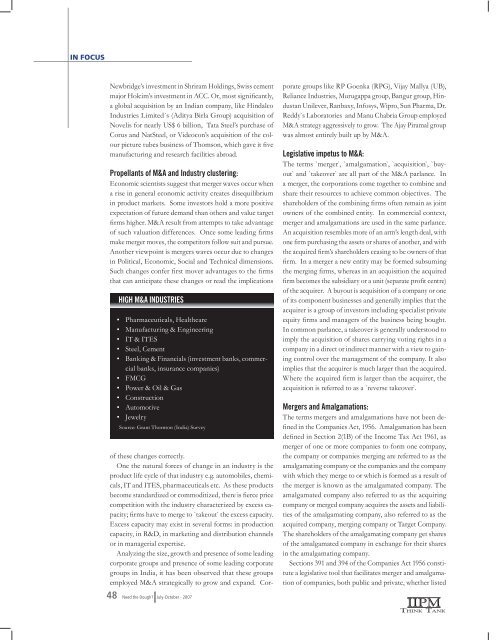india going global.indd - The IIPM Think Tank
india going global.indd - The IIPM Think Tank
india going global.indd - The IIPM Think Tank
You also want an ePaper? Increase the reach of your titles
YUMPU automatically turns print PDFs into web optimized ePapers that Google loves.
IN FOCUS<br />
Newbridge’s investment in Shriram Holdings, Swiss cement<br />
major Holcim’s investment in ACC. Or, most significantly,<br />
a <strong>global</strong> acquisition by an Indian company, like Hindalco<br />
Industries Limited`s (Aditya Birla Group) acquisition of<br />
Novelis for nearly US$ 6 billion, Tata Steel’s purchase of<br />
Corus and NatSteel, or Videocon’s acquisition of the colour<br />
picture tubes business of Thomson, which gave it five<br />
manufacturing and research facilities abroad.<br />
Propellants of M&A and Industry clustering:<br />
Economic scientists suggest that merger waves occur when<br />
a rise in general economic activity creates disequilibrium<br />
in product markets. Some investors hold a more positive<br />
expectation of future demand than others and value target<br />
firms higher. M&A result from attempts to take advantage<br />
of such valuation differences. Once some leading firms<br />
make merger moves, the competitors follow suit and pursue.<br />
Another viewpoint is mergers waves occur due to changes<br />
in Political, Economic, Social and Technical dimensions.<br />
Such changes confer first mover advantages to the firms<br />
that can anticipate these changes or read the implications<br />
HIGH M&A INDUSTRIES<br />
• Pharmaceuticals, Healthcare<br />
• Manufacturing & Engineering<br />
• IT & ITES<br />
• Steel, Cement<br />
• Banking & Financials (investment banks, commercial<br />
banks, insurance companies)<br />
• FMCG<br />
• Power & Oil & Gas<br />
• Construction<br />
• Automotive<br />
• Jewelry<br />
Source: Grant Thornton (India) Survey<br />
of these changes correctly.<br />
One the natural forces of change in an industry is the<br />
product life cycle of that industry e.g. automobiles, chemicals,<br />
IT and ITES, pharmaceuticals etc. As these products<br />
become standardized or commoditized, there is fierce price<br />
competition with the industry characterized by excess capacity;<br />
firms have to merge to `takeout` the excess capacity.<br />
Excess capacity may exist in several forms: in production<br />
capacity, in R&D, in marketing and distribution channels<br />
or in managerial expertise.<br />
Analyzing the size, growth and presence of some leading<br />
corporate groups and presence of some leading corporate<br />
groups in India, it has been observed that these groups<br />
employed M&A strategically to grow and expand. Corporate<br />
groups like RP Goenka (RPG), Vijay Mallya (UB),<br />
Reliance Industries, Murugappa group, Bangur group, Hindustan<br />
Unilever, Ranbaxy, Infosys, Wipro, Sun Pharma, Dr.<br />
Reddy`s Laboratories and Manu Chabria Group employed<br />
M&A strategy aggressively to grow. <strong>The</strong> Ajay Piramal group<br />
was almost entirely built up by M&A.<br />
Legislative impetus to M&A:<br />
<strong>The</strong> terms `merger`, `amalgamation`, `acquisition`, `buyout`<br />
and `takeover` are all part of the M&A parlance. In<br />
a merger, the corporations come together to combine and<br />
share their resources to achieve common objectives. <strong>The</strong><br />
shareholders of the combining firms often remain as joint<br />
owners of the combined entity. In commercial context,<br />
merger and amalgamations are used in the same parlance.<br />
An acquisition resembles more of an arm’s length deal, with<br />
one firm purchasing the assets or shares of another, and with<br />
the acquired firm’s shareholders ceasing to be owners of that<br />
firm. In a merger a new entity may be formed subsuming<br />
the merging firms, whereas in an acquisition the acquired<br />
firm becomes the subsidiary or a unit (separate profit centre)<br />
of the acquirer. A buyout is acquisition of a company or one<br />
of its component businesses and generally implies that the<br />
acquirer is a group of investors including specialist private<br />
equity firms and managers of the business being bought.<br />
In common parlance, a takeover is generally understood to<br />
imply the acquisition of shares carrying voting rights in a<br />
company in a direct or indirect manner with a view to gaining<br />
control over the management of the company. It also<br />
implies that the acquirer is much larger than the acquired.<br />
Where the acquired firm is larger than the acquirer, the<br />
acquisition is referred to as a `reverse takeover`.<br />
Mergers and Amalgamations:<br />
<strong>The</strong> terms mergers and amalgamations have not been defined<br />
in the Companies Act, 1956. Amalgamation has been<br />
defined in Section 2(1B) of the Income Tax Act 1961, as<br />
merger of one or more companies to form one company,<br />
the company or companies merging are referred to as the<br />
amalgamating company or the companies and the company<br />
with which they merge to or which is formed as a result of<br />
the merger is known as the amalgamated company. <strong>The</strong><br />
amalgamated company also referred to as the acquiring<br />
company or merged company acquires the assets and liabilities<br />
of the amalgamating company, also referred to as the<br />
acquired company, merging company or Target Company.<br />
<strong>The</strong> shareholders of the amalgamating company get shares<br />
of the amalgamated company in exchange for their shares<br />
in the amalgamating company.<br />
Sections 391 and 394 of the Companies Act 1956 constitute<br />
a legislative tool that facilitates merger and amalgamation<br />
of companies, both public and private, whether listed<br />
48 Need the Dough July-October - 2007





![[Feb 2008, Volume V Annual Issue] Pdf File size - The IIPM Think Tank](https://img.yumpu.com/43961117/1/190x245/feb-2008-volume-v-annual-issue-pdf-file-size-the-iipm-think-tank.jpg?quality=85)
![[June 2008, Volume V Quarterly Issue] Pdf File size - The IIPM Think ...](https://img.yumpu.com/41693247/1/190x245/june-2008-volume-v-quarterly-issue-pdf-file-size-the-iipm-think-.jpg?quality=85)







![[Dec 2007, Volume 4 Quarterly Issue] Pdf File size - The IIPM Think ...](https://img.yumpu.com/29766298/1/190x245/dec-2007-volume-4-quarterly-issue-pdf-file-size-the-iipm-think-.jpg?quality=85)

![[Volume VI | Quarterly Issue: 31st May 2009] Pdf File size](https://img.yumpu.com/27796051/1/190x245/volume-vi-quarterly-issue-31st-may-2009-pdf-file-size.jpg?quality=85)